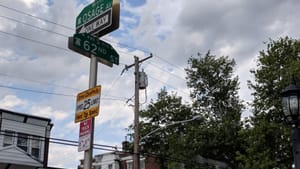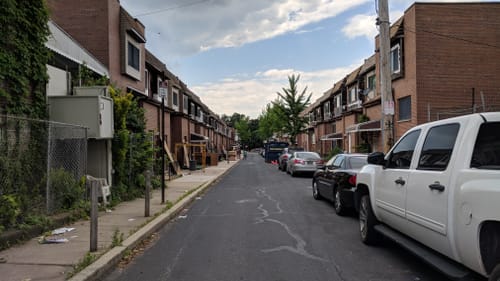Stay in the Loop
BSR publishes on a weekly schedule, with an email newsletter every Wednesday and Thursday morning. There’s no paywall, and subscribing is always free.
Movements of a legacy
Thirty-four years later: My Osage Avenue neighborhood

Legacy is defined as a gift or a bequest; it’s handed down, endowed, or conveyed from one person to another. You get it from a predecessor; it descends into your possession. Sometimes this happens whether you like it or not. It can be something you’re born into, something that informs your identity.
“Where are you from?”
In 2008, a friend who identified strongly with her Polish heritage asked me something that no one had ever asked me: Where are you from?
I remember this vividly. It took me aback. It wasn’t something I had really thought about. Sure, I knew my family had been brought to America on slave ships, and had integrated partly with Mohican tribe members in the early 1900s, but that was about it. I couldn’t claim identity, like I’m Italian American or I’m Polish, like you. “African American” makes me cringe—as if Africa is one generic culture or country. But I also can’t claim something like Nigerian American or Eritrean American, either.
To have a modifier on your identity as an American is convenient. Should America, should home, disown you—should the empire fall—you’d have the chance to return to that other home. To speak that language that is yours. To fit in without judgment. That’s not a convenience many Black Americans have.
Where am I from? I come from darkness, and you can see it on my skin. You don’t have to ask.
Home for me is West Philadelphia. And when I answer where in West Philly I grew up, people’s faces light up. Their mouths gape for a second, drawing in air and letting out: Ooooh, you grew up on Osage? Were you alive when…?
I wasn’t. Well, I was a tiny something hanging out in my mom’s tummy, and she probably didn’t even know about me then. What she did know is that a bomb rained down on the block a few streets down.
The war at the edge of the city
On Mother’s Day 1985, the Philadelphia Police Department dropped two one-pound tubes filled with an FBI-supplied water-based gel explosive on a house at 6221 Osage Avenue. This came in response to tensions rising between the MOVE organization and the City of Philadelphia over several years. Founded by Vincent Leaphart, otherwise known as John Africa, MOVE (still active in Philadelphia today) was a Black liberation group that sought revolution in politics and civil rights. Members protested animal cruelty, the education system, and police brutality.
What sparked, as a result, was a terrorist attack by the city on its own people. It was a disowning. It was an empire crumbling. West Philadelphia was on fire.

It’s never been sunny in Philadelphia
Wilson Goode, the first Black mayor in the city, was elected after the infamous Frank Rizzo’s terms ended. Rizzo unabashedly opposed MOVE. He infused an aggressive tone into the attitude of other conservative Philadelphia politicians and the already problematic police department. On the other hand, Goode promised unity among “whites, blacks, Asians, and Hispanics” in a speech after his election on November 8, 1983. A graduate of Morgan State University, a historically black college, he was aligned to be the breath of fresh air the city’s disparaged black and brown people desperately needed.
Two years later, he had a hand in one of the darkest moments in US history.
Philadelphia is a city many of my friends and colleagues claim to adore and care for. But I try to recall, research, and remind others of its tumultuous history. Police brutality in the 1960s and ’70s was a significant epidemic, including the North Philadelphia riots of 1964 and the PPD’s first fatal standoff with MOVE in 1978—the year my sister was born.
Being black in Philadelphia was never safe, and that racism, which may or may not be as apparent to some, continues to resonate in the city. I can still feel the reverberation that maintains its clandestine imbalance.
Every mayor—particularly every Black mayor in Philadelphia—beholds a legacy on behalf of Goode. But the recollection of the bombing steadily slips. Having cloudy reports doesn’t help.
Failing your neighbor
After dozens of hours of hearings following the bombing, police commissioner Gregore J. Sambor, fire commissioner William Richmond, and Goode delivered inconsistent testimonies. Communication was broken, and if you listen to or read the testimonies, it almost sounds like the confusion was intentional.
What makes this more complicated are the testimonies made by residents of the 6200 block of Osage and its neighboring streets. In a television news report, neighbors made claims of physical and verbal abuse by MOVE members. Further, one of the people noted that Goode was condescending and dismissive of their pleas for the city to do something about their complaints.
MOVE wasn’t perfect, but neither was the city of Philadelphia. Bombing your own citizens is a terrorist attack. It’s an act of disowning. It’s evidence of a crumbled empire—perhaps of a false empire. West Philadelphia was set on fire by the people who were meant to protect and serve, against a group who sought revolution over political and civil rights and policies.

From the ground up
Eleven lives and 61 homes were destroyed or damaged. Two hundred and forty people were left without homes. Goode had promised that the block would be rebuilt within a year. The homes were rebuilt later, but under a controversial developer who landed in jail before construction was done. It wasn’t until 2017 that the rebuilding process began again, placed in seemingly capable and empathetic hands.
Construction of new homes is happening now on the entire block. There is hope. Finally. But it will take more time for the community to redefine and reestablish itself and its identity.
Claiming Cobbs Creek
I can’t claim that the bombing is part of my history, but it is part of my legacy. The identity I’m forging is a culmination of influences close to home and far away. Walking through the Cobbs Creek area restores me, and nothing else feels like home. I can’t claim other countries or tribes as my own, but I can claim Cobbs Creek. And while I vicariously wrestle with the feelings of betrayal my neighbors feel from the city and continue to cultivate my own identity, I occasionally return to Osage to reset my balance and my perspective, to recall memories that have started to slip, and to practice upholding responsibility and compassion, when counterparts in my legacy failed to do so.
When people ask me where I’m from, I say I’m from Osage.
Sign up for our newsletter
All of the week's new articles, all in one place. Sign up for the free weekly BSR newsletters, and don't miss a conversation.

 Kyle V. Hiller
Kyle V. Hiller